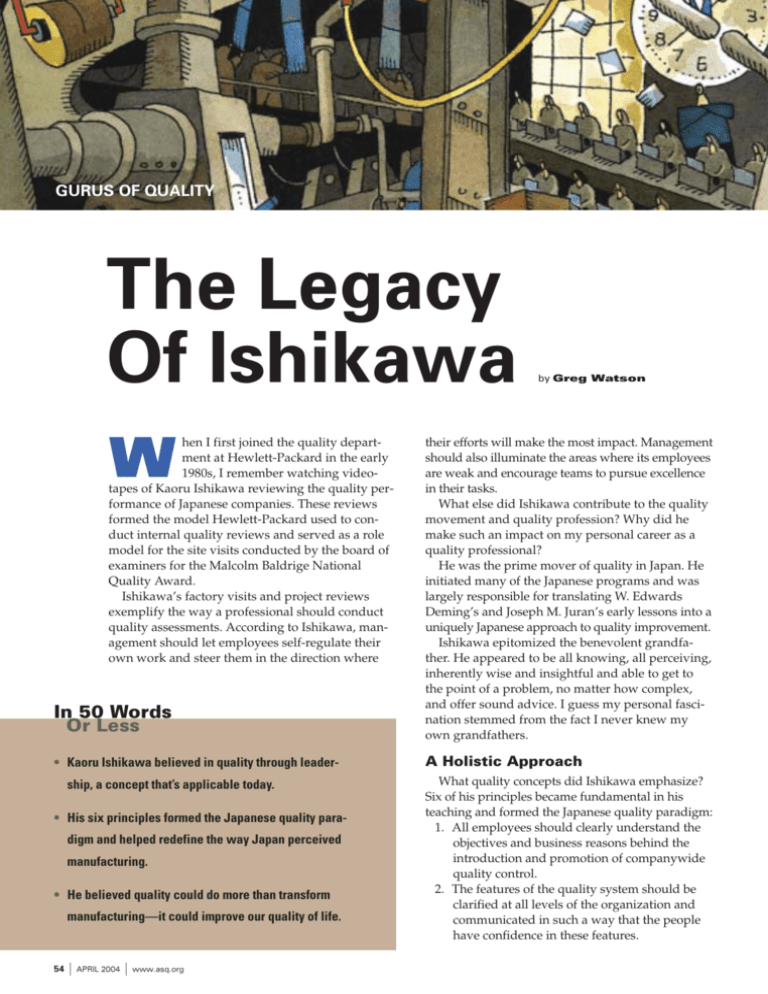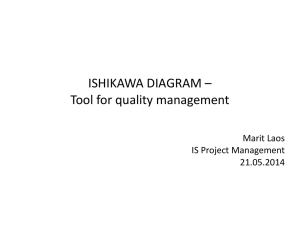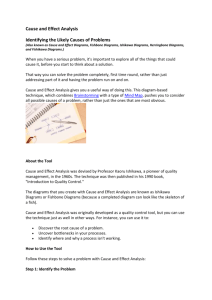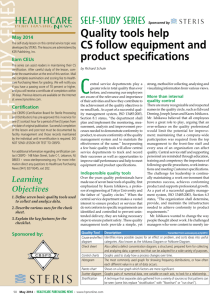The Legacy of ishikawa
advertisement

GURUS OF QUALITY The Legacy Of Ishikawa W hen I first joined the quality department at Hewlett-Packard in the early 1980s, I remember watching videotapes of Kaoru Ishikawa reviewing the quality performance of Japanese companies. These reviews formed the model Hewlett-Packard used to conduct internal quality reviews and served as a role model for the site visits conducted by the board of examiners for the Malcolm Baldrige National Quality Award. Ishikawa’s factory visits and project reviews exemplify the way a professional should conduct quality assessments. According to Ishikawa, management should let employees self-regulate their own work and steer them in the direction where In 50 Words Or Less • Kaoru Ishikawa believed in quality through leadership, a concept that’s applicable today. • His six principles formed the Japanese quality paradigm and helped redefine the way Japan perceived manufacturing. • He believed quality could do more than transform manufacturing—it could improve our quality of life. 54 I APRIL 2004 I www.asq.org by Greg Watson their efforts will make the most impact. Management should also illuminate the areas where its employees are weak and encourage teams to pursue excellence in their tasks. What else did Ishikawa contribute to the quality movement and quality profession? Why did he make such an impact on my personal career as a quality professional? He was the prime mover of quality in Japan. He initiated many of the Japanese programs and was largely responsible for translating W. Edwards Deming’s and Joseph M. Juran’s early lessons into a uniquely Japanese approach to quality improvement. Ishikawa epitomized the benevolent grandfather. He appeared to be all knowing, all perceiving, inherently wise and insightful and able to get to the point of a problem, no matter how complex, and offer sound advice. I guess my personal fascination stemmed from the fact I never knew my own grandfathers. A Holistic Approach What quality concepts did Ishikawa emphasize? Six of his principles became fundamental in his teaching and formed the Japanese quality paradigm: 1. All employees should clearly understand the objectives and business reasons behind the introduction and promotion of companywide quality control. 2. The features of the quality system should be clarified at all levels of the organization and communicated in such a way that the people have confidence in these features. 3. The continuous improvement cycle should be continuously applied throughout the whole company for at least three to five years to develop standardized work. Both statistical quality control and process analysis should be used, and upstream control for suppliers should be developed and effectively applied. 4. The company should define a long-term quality plan and carry it out systematically. 5. The walls between departments or functions should be broken down, and cross functional management should be applied. 6. Everyone should act with confidence, believing his or her work will bear fruit. Ishikawa blended these ideas and principles into a system of quality thinking that defined a holistic way to achieve the improvement of business performance. He proposed a pursuit of quality that can be best described as integrated quality. As Ishikawa once said: “Quality should not be interpreted in the narrow sense but interpreted broadly, including price, delivery and safety, to satisfy consumer’s needs. This … attitude involves various elements of technology.” Quality Through Leadership The six principles described by Ishikawa define the four major focus areas of the Japanese approach to influence quality through leadership. These four areas have been particularly important in my personal quality journey: 1. Market-in quality. 2. Worker involvement. 3. Quality begins and ends with education. 4. Selfless personal commitment. Market-in quality: Ishikawa knew quality could provide a strong contribution to business competitiveness when an organization learned to evaluate its products and services according to the standard of customer acceptability. Once the customer requirements are defined, the internal process chain that delivers value to the market must be inextricably linked to the external customer. Taking this business focused, companywide approach to quality work requires hands-on leadership by top management. Ishikawa emphasized this strategic perspective by making “quality first” the basic principle for any organization’s operating philosophy. He focused the world on defining quality from the view of the customer rather than the internal perspective of the company. His emphasis on the business customer was unique at the time because most quality efforts focused on industrial quality control and internal applications for manufacturing. Ishikawa created customer focus within the quality movement, and today, this is the fundamental starting point of quality. Although all quality professionals would echo this perspective, we have Ishikawa to thank for driving home the point that “customers are the only reason for our business.” Worker involvement: Ishikawa was the father of quality control circles. He believed all workers must be involved in quality improvement through teams to enhance the capability of individual workers and improve work processes. All work must include both corrective and preventive action to uncover and resolve problems downstream from the customer engagement point. This is the most cost effective way to operate. To be able to perform these tasks, workers must be trained in basic problem solving tools and quality control methods and work in cross functional teams to resolve process problems that cross the functional boundaries of workgroups. Ishikawa emphasized teaching workers about the basic quality tools to equip them with the ability to be self-regulatory in their work environment. This supported both the quality improvement and productivity emphases in Japanese management. Ishikawa’s unique conviction that workers had the ability to make creative contributions to improve the performance of their work arose out of his direct experience with Japanese workers in improving chemical work processes and grew with each subsequent exposure to the frontline workers of the gemba (workplace). Today, we think walking around the workplace and involving employees are natural aspects of good management, but we should really be thanking Ishikawa for his convictions. QUALITY PROGRESS I APRIL 2004 I 55 GURUS OF QUALITY Quality begins and ends with education: To understand the true meaning of Ishikawa’s teaching about education, it is essential to recognize how he differentiated between education and training. He believed training improves skills and competence, and education builds a person’s character and develops a deeper level of understanding. Ishikawa put his ideas together into a systematic perspective of quality that is pervasive today: “Ninety percent of all problems can be solved by using the techniques of data stratification, histograms and control charts. Among the causes of nonconformance, only one-fifth or less are attributable to the workers.” Education accelerates life experience and enables people to understand truth. Ishikawa taught that the next step in each work process is the customer, who deserves attention, and processes should be analyzed to uncover the facts and data about performance from the viewpoint of the customer. Customer oriented quality requires breaking down functional boundaries that inhibit the flow of defect free products to the market. Education transforms workers into informed skeptics when they follow Ishikawa’s advice: “When you see the data, doubt them! When you see the measurement instrument, doubt it! When you see the analysis, doubt it!” This epithet describes the philosophy of Six Sigma Black Belts, who quickly learn not all data are good—a point originally made by Ishikawa more than 25 years ago. Education creates understanding and a willingness to doubt because doubters have confidence in their ability to find the truth. If members of a management team provide education for their workers, the workers can collectively determine the best way to manage the work processes and produce the outcomes required by customers. Universal worker education in basic quality tools and methods is another legacy of Ishikawa we accept as a standard work practice. Selfless personal commitment: Juran’s eulogy for Ishikawa is one of the greatest tributes I have read: There is so much to be learned by studying how Ishikawa managed to accomplish so much during a single lifetime. In my observation, he did so by applying his natural gifts in an exemplary way. He was dedicated to serving society rather than serv56 I APRIL 2004 I www.asq.org ing himself. His manner was modest, and this elicited the cooperation of others. He followed his own teachings by securing facts and subjecting them to rigorous analysis. He was completely sincere, and as a result was trusted completely.1 The greatest impact Ishikawa and several of his students—most notably Yoshio Kondo, Noriaki Kano and Hitoche Kume—have had on me is to convince me it is worthwhile to dedicate our time to help improve the quality of life in the world by improving the quality of the way we work together. One lesser known quote from Ishikawa illustrates the depth of his personal commitment to global quality: “I am convinced world peace and prosperity need quality control. This is why quality control will have to be taught and spread around the world.” The Gift of a Role Model Those who were close to Ishikawa would know he sometimes criticized them for not focusing their attention on the important aspects of improvement. One of his most often used words was damyi—the Japanese word used to rebuke children and cause them to stop bad behavior. Maybe this word should be used more in our business environment where balance is often not achieved between participatory management and the strong coaching style needed to get people to the point of self-discovery. Ishikawa not only talked about how to manage this way; he also provided a living example of it, giving quality professionals someone to emulate for years to come. When Kano first told me about the way he was constructively criticized by Ishikawa, it helped me understand my fascination with him. Ishikawa always behaved as a benevolent grandfather to both his students and his clients. Kano’s insights helped me understand I saw Ishikawa as a grandfather of quality because that was how he acted. Now I know I am in good company. REFERENCE 1. Kenneth S. Stephens, editor, International Academy for Quality: Best of Quality, Vol. 13, ASQ Quality Press, 2002, p. 187. BIBLIOGRAPHY Ishikawa, Kaoru, What Is Total Quality Control? The Japanese Way, translated by David J. Lu, Prentice-Hall, 1985. The Life of Kaoru Ishikawa The lifetime work of Kaoru Ishikawa (1916-1989) was extensive. He received his doctorate of philosophy in chemical engineering in 1939 from the University of Tokyo. He wrote 647 articles and 31 books, including two that were translated into English: Introduction to Quality Control and What Is Total Quality Control? The Japanese Way. He is well known for coming up with the concept for the fishbone shaped diagram, known as the Ishikawa or cause and effect diagram, used to improve the performance of teams in determining potential root causes of their quality problems. Ishikawa developed and delivered the first basic quality control course for the Union of Japanese Scientists and Engineers (JUSE) in 1949 and is credited with creating the Japanese quality circle movement in 1962. Perhaps the most dominant leader in JUSE, Ishikawa also served as president of the Japanese Society for Quality Control and the Musashi Institute of Technology and co-founded and served as president of the International Academy for Quality. Upon retirement, he was named professor emeritus of the University of Tokyo, Honorary Member of ASQ and honorary member of the International Academy for Quality. Ishikawa received many awards and honors, including ASQ’s Eugene L. Grant Award in 1972 and the Walter A. Shewhart Medal in 1988. He was given the Shewhart Medal for “his outstanding contributions to the development of quality control theory, principles, techniques and standardization activities for both Japanese and world industry, which enhanced quality and productivity.”1 ASQ named a national medal after him in 1993, recognizing him as a “distinguished pioneer in the achievement of respect for humanity in the quality disciplines.” Then the Asian Pacific Quality Organization named the Harrington-Ishikawa Medal after him to recognize a quality professional who has made a substantial contribution to the promotion of quality programs and methods in the Asian Pacific. Ishikawa was also a recipient of the Second Order of the Sacred Treasure from the Emperor of Japan—the same recognition bestowed upon W. Edwards Deming and Joseph M. Juran. REFERENCE 1. Kenneth S. Stephens, editor, International Academy for Quality: Best of Quality, Vol. 13, ASQ Quality Press, 2002. Stephens, Kenneth S., editor, International Academy for Quality: Best of Quality, Vol. 13, ASQ Quality Press, 2002. GREGORY H. WATSON is a past-president and Fellow of ASQ, president of Business Systems Solutions, assistant professor of industrial engineering at Oklahoma State University and a member of the ASQ research committee. Please comment If you would like to comment on this article, please post your remarks on the Quality Progress Discussion Board at http://www.asq.org, or e-mail them to editor@asq.org. QUALITY PROGRESS I APRIL 2004 I 57





